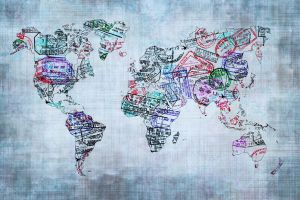
Data roaming while travelling has historically been expensive for South Africans, and exclusive to contract customers. Vodacom charges around 49c per MB out of bundle, and MTN charges by destination.
A quick search of MTN rates for the US, Thailand, Rwanda, and Turkey offered 99c per MB. For Spain, it offered the same rate for Vodafone, Orange, and Telefonica, except for Xfera, which was R2.50/MB.
When you calculate what 500MB or 1GB costs while roaming, it gets a bit ridiculous. It’s not worth it for a holiday, and should only be an option if your company is footing your phone bill after a business trip.
Old school is out
I’ve tested various options and services over the years, including the old-fashioned way – buying a local SIM when you arrive in a new country. But queueing, and handing over your passport and other personal information is not appealing. We don’t know where our data sits, who has access to it and how secure it is.
I also tried KnowRoaming, a sticker for my SIM that activates abroad and offers up to 85% savings on data costs. It served me well despite being buggy, but now with eSIM support, it’s a game changer. If you missed my previous post, I covered eSIMs in this post. Have a read to see which smartphones support eSIM.
I’ve since tested eSIM options. For me, it comes down to the anonymity of getting an eSIM without giving up data and using Apple Pay or similar.
eSIM is in
There are various eSIM options like TravelSIM which is currently offering specials for the FIFA World Cup and Truphone which has been around since the iPad cellular (you need a US App Store account). I’ve switched to Airalo, but Holafly is another option – it works in fewer regions but offers unlimited 4G.
Between Truphone and Airalo, I prefer the latter. It has better rates, a clean interface, and a robust referral scheme. You can buy an eSIM by country or region, i.e., Europe, Asia, Africa, Latin America, etc.
Airalo is available on Android and iOS and covers 190+ countries. Its extensive reach was a drawcard for me when I realised other providers didn’t cover Rwanda, which was a requirement as we were travelling there a few months ago. And for every person I referred, I received $3 each in credit. Who doesn’t like being rewarded for loyalty?
I used Airalo extensively in the US over the last few months and appreciated the 5G support, as most other providers offer 4G speeds.
The convenience and price far outweigh the roaming rates mentioned earlier or the effort involved to buy a physical SIM.
A 10GB package in the US costs $26 but topping up gets cheaper the bigger the bundle/validity. Since iPhone pairs seamlessly with Mac, I could work from anywhere.
While Airalo remains my preferred data solution when travelling, I’m open to buying a local SIM in regions where it’s significantly cheaper with easy access, and if there’s an eSIM option from the provider it’s a bonus. Then I don’t have to worry about misplacing a nano SIM.
If you don’t want a data cap on your eSIM package, and prefer an unlimited 4G connection, check out Holafly. I have not tried it because Airalo is so good at what it does and covers more regions.
If you have an upcoming trip and want to try Airalo, feel free to use my sign-up code or apply it at checkout against your first purchase.
Stay safe and stay connected.
Cache This

